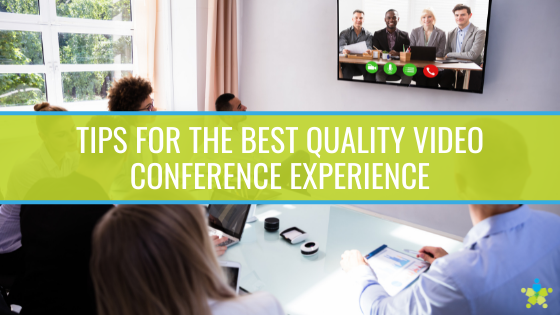Remote work is increasing at an unprecedented rate, and that means more and more professionals are spending much of their time video conferencing. According to Upwork’s 2021 Future of Workforce Pulse Report, the number of remote workers is expected to increase by 87 percent by 2025. Learning how to video conference effectively is an important skill for the modern workforce, but it’s not so tough with some simple tips.
Test everything before the meeting and arrive early
It’s highly recommended that you test your equipment before entering a video meeting. This is especially important if you’ve changed your setup (software or hardware) before your last video conference. If you’re short on time, the most important things to check are your audio levels, lighting and camera framing. That way, you’ll at least know you can be seen and heard clearly.
Another recommendation is to connect to the video conference early. That will ensure you’re familiar with the interface, so you know how to mute your microphone or toggle your camera. Arriving early also gives you some advance notice if you’re having connection issues, so they can be remedied right away. If there’s another early arriver in the room, they can also verify that your audio and video quality are on point.
Doing all of this ahead of time minimizes the chances that you’ll have to come up with a fix while on a call, which is likely to cause the kind of stress that makes quick problem solving difficult.
Know where to position your lighting and camera
Poor lighting or an awkward camera angle are extremely distracting problems, but they have simple fixes. Here’s where to position both:Lighting -
Natural light is almost always the best option when it’s available, such as through a window, but positioning is everything. If the window is behind you, your camera will have trouble with proper exposure and may leave you looking like a silhouette. The best place to video conference relative to a window is to the side or in front. In either case, natural light should be softened so it doesn’t result in harsh shadows. This can be done with a window sheer or blinds.
If natural lighting isn’t available, consider a light source developed specifically for video conferencing. The Lume Cube is one such option, and provides a compact, powerful illumination source that looks like natural light and can be mounted on a desk.
Camera -
Cameras designed for remote workers are affordable, compact, easy to connect and can be mounted to a monitor or laptop. To ensure the most flattering and least distracting angle, though, make sure your camera sits at eye level. Any lower and your colleagues will be staring up your nose. Any higher and people will think you’re looking up at them. Try to look into the camera while conferencing to show you are in tune with the meeting.
Opt for a wired connection when video conferencing
Connection issues are common when video conferencing over WiFi, but using an Ethernet cable can improve connection stability. When video conferencing from home, be mindful of your household’s bandwidth use, too. Shutting down unnecessary bandwidth hogs (like streaming services) will give your network the speed it needs to ensure a high-quality video conferencing experience.
Consider a dual-display setup for enhanced presentations
In conference room settings, there is typically plenty of room to go bigger with a video conferencing solution. For example, many businesses outfit their conference spaces with two displays instead of just one. A second display can be used to deliver presentation materials while the primary display provides video of the speaker. This is helpful for the person doing the presenting and the people observing it. The meeting’s presenter doesn’t have to worry about how to share content or visualize data for the audience. The meeting’s participants get all of the visual information they need to follow along.
Interactivity can be a powerful addition to your conference spaces
If a dual-display solution sounds like the right approach, an interactive display may make the most sense. Interactive displays are a proven learning tool in educational settings, and they can drive better, more engaging meetings as well. With an interactive display, presenters can begin a whiteboarding session, bring in visual aids or examples, annotate over them and allow other meeting members to add their own notes. Modern whiteboarding software is designed for people video conferencing from anywhere, so even if your team relies on mobile conferencing, they can still engage with whiteboarding software.
Boost your audio quality with the right microphones or headsets
Even if your video quality is pristine, poor audio can negatively affect a meeting. Most of the time, audio issues arise from an ineffective setup. Perhaps the microphone is too far away or not configured properly. Maybe the speaker is too close to the microphone. Background noise can also interfere with the meeting. Whatever the issue is, remote workers can maximize audio quality by wearing a headset with a quality microphone. This will prevent any problems related to microphone or speaker positioning.
In a professional conference space, make sure there are enough microphones for everyone and ensure you have the right microphones for the room. Gooseneck microphones, for instance, deliver high quality audio but take up considerable desk space. Ceiling microphones are out of way, but may pick up ambient audio, such as an air conditioning system.An AV integrator can help their clients pick the right microphones for their conferencing rooms, along with the right displays, the right conferencing platform and anything else a remote team may need to create the best quality video conferencing experience.



